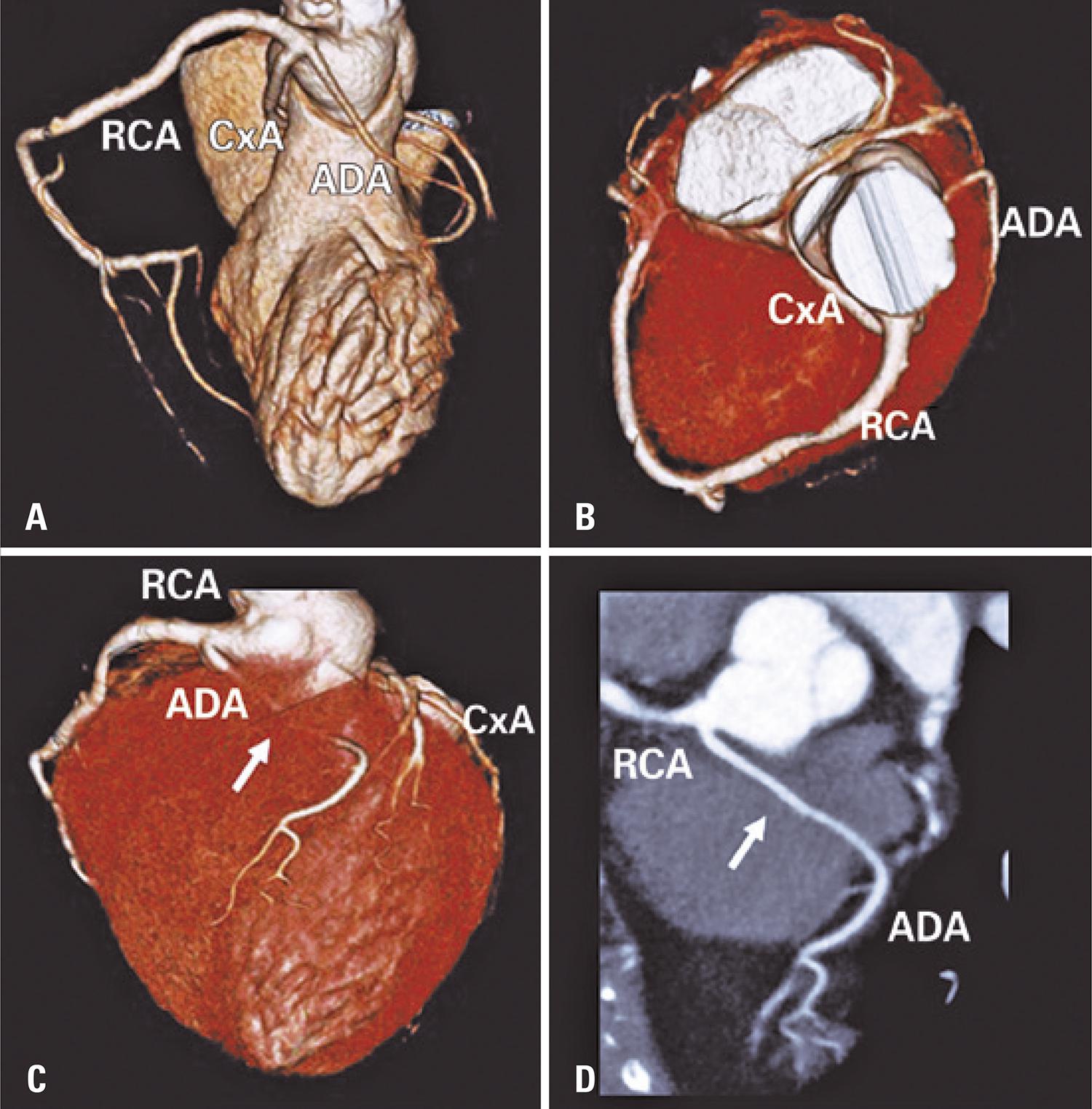A 62-year-old patient referred to coronary angiotomography due to ischemic changes detected in an exercise stress test. The patient reported hypertension and dyslipidemia, both controlled with drug treatment and regular physical exercise. She didn’t have any cardiovascular complaints and her physical examination was unremarkable.
Coronary angiotomography showed common origin of coronary arteries through a short common trunk, emerging from the right Valsalva sinus and trifurcating into right coronary artery (RCA), circumflex artery (CxA) and anterior descending artery (ADA). The RCA had habitual course and gives rise to the posterior descending artery (right-dominance). The CxA had a small caliber and retroaortic course without luminal. The ADA had an important angulation in its origin, interarterial course in subvalvar plan and a long proximal intramyocardial segment, where it exhibited a reduction of its diameter, without plaques or parietal changes ( Figure 1 ).
Tridimensional volumetric reconstruction. Right lateral view (A), cranial view (B), anterior view (C) and multiplanar reconstruction (D) of coronary angiotomography showing the common origin of coronary arteries through a short common trunk, emerging from right Valsalva sinus and trifurcating into right coronary artery, circumflex artery, anterior descending artery, and highlighting both an intra-arterial course of anterior descending artery, between aorta and pulmonary trunk, and a long proximal intramyocardial course (arrow)
RCA: right coronary artery; CxA: circumflex artery; ADA: anterior descending artery.
Anomalies of origin and coronary course are relatively common findings,11. Cademartiri F, La Grutta L, Malagò R, Alberghina F, Meijboom WB, Pugliese F, et al. Prevalence of anatomical variants and coronary anomaliesin 543 consecutive patients studied with 64-slice CT coronary angiography. Eur Radiol. 2008;18(4):781-91. and they can generate ischemia or have no clinical significance. The coronary angiotomography is the goldstandard for anatomy assessment showing coronary courses and their myocardial relationship,11. Cademartiri F, La Grutta L, Malagò R, Alberghina F, Meijboom WB, Pugliese F, et al. Prevalence of anatomical variants and coronary anomaliesin 543 consecutive patients studied with 64-slice CT coronary angiography. Eur Radiol. 2008;18(4):781-91.
2. Tsioufis K, Latsios G, Tousoulis D, Kallikazaros I, Stefanadis C. Anomalous common origin of all coronary arteries with a common ostium from the left sinus of Valsalva. Int J Cardiol. 2010;139(3): e47-9.
3. Pasaoglu L, Toprak U, Nalbant E, Yagiz G. A rare coronary artery anomaly: origin of all three coronary arteries from the right sinus of valsalva. J Clin Imaging Sci. 2015;5:25.
4. Rao A, Yadu N. Common origin of the coronary arteries: a rare coronary artery anomaly. Med J Armed Forces India. 2016;72(Suppl 1):S189-91.
5. Angelini P. Coronary artery anomalies: an entity in search of an identity. Circulation. 2007;115(10):1296-305. Review. - 66. Malagò R, D’Onofrio M, Brunelli S, La Grutta L, Midiri M, Travella D, et al. Anatomical variants and anomalies of the coronary tree studied with MDCT coronary angiography. Radiol Med. 2010;115(5):679-92. Review. elegantly depicted by volumetric reconstructions. Among described anomalies, reports about common origin of the coronary arteries by single trunk from the right Valsalva sinus are rare.22. Tsioufis K, Latsios G, Tousoulis D, Kallikazaros I, Stefanadis C. Anomalous common origin of all coronary arteries with a common ostium from the left sinus of Valsalva. Int J Cardiol. 2010;139(3): e47-9.
3. Pasaoglu L, Toprak U, Nalbant E, Yagiz G. A rare coronary artery anomaly: origin of all three coronary arteries from the right sinus of valsalva. J Clin Imaging Sci. 2015;5:25. - 44. Rao A, Yadu N. Common origin of the coronary arteries: a rare coronary artery anomaly. Med J Armed Forces India. 2016;72(Suppl 1):S189-91. To the best of our knowledge, the association of this set of findings with a long intramyocardial course of the anterior descending artery, determining local vessel compression in ideal conditions of exam (diastolic acquisition with vasodilation and heart rate control) was not previous reported in the published literature, therefore, this is the first case to be reported.
REFERENCES
-
1Cademartiri F, La Grutta L, Malagò R, Alberghina F, Meijboom WB, Pugliese F, et al. Prevalence of anatomical variants and coronary anomaliesin 543 consecutive patients studied with 64-slice CT coronary angiography. Eur Radiol. 2008;18(4):781-91.
-
2Tsioufis K, Latsios G, Tousoulis D, Kallikazaros I, Stefanadis C. Anomalous common origin of all coronary arteries with a common ostium from the left sinus of Valsalva. Int J Cardiol. 2010;139(3): e47-9.
-
3Pasaoglu L, Toprak U, Nalbant E, Yagiz G. A rare coronary artery anomaly: origin of all three coronary arteries from the right sinus of valsalva. J Clin Imaging Sci. 2015;5:25.
-
4Rao A, Yadu N. Common origin of the coronary arteries: a rare coronary artery anomaly. Med J Armed Forces India. 2016;72(Suppl 1):S189-91.
-
5Angelini P. Coronary artery anomalies: an entity in search of an identity. Circulation. 2007;115(10):1296-305. Review.
-
6Malagò R, D’Onofrio M, Brunelli S, La Grutta L, Midiri M, Travella D, et al. Anatomical variants and anomalies of the coronary tree studied with MDCT coronary angiography. Radiol Med. 2010;115(5):679-92. Review.
Publication Dates
-
Publication in this collection
25 Nov 2019 -
Date of issue
2020
History
-
Received
26 May 2019 -
Accepted
1 July 2019


